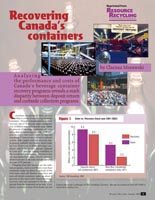
Analyzing the performance and costs of Canada’s beverage container recovery programs reveals a stark disparity between deposit-return and curbside collection programs.
Canadians are proud of their success when it comes to recovering beverage containers. Overall, Canada maintains a total recovery rate of 70 percent, representing just over 10 billion units collected per year. About 63 percent of beverage containers are sold into a deposit-return regime, with an 86 percent recovery rate (see Figure 1), and the remaining 37 percent are sold into a curbside system, with roughly half that recovery rate. In general, refillable beer bottles, which make up over 25 percent of all the beverage containers sold in the country and are captured at a rate of 97 percent, largely contribute to the overall national success. Second in line are aluminum beer cans, which comprise about 8 percent of the total and are captured at a rate of 85 percent.
Chipping back this success are the curbside programs, such as in Ontario (non-beer containers make up about 26 percent of the total units sold) and Quebec (non-beer and non-soft-drink containers make up about 8 percent of the total sold) where beverage recovery rates are estimated to be about 42 percent from the residential sector only. Containers consumed away from home are not accounted for in these provinces.

